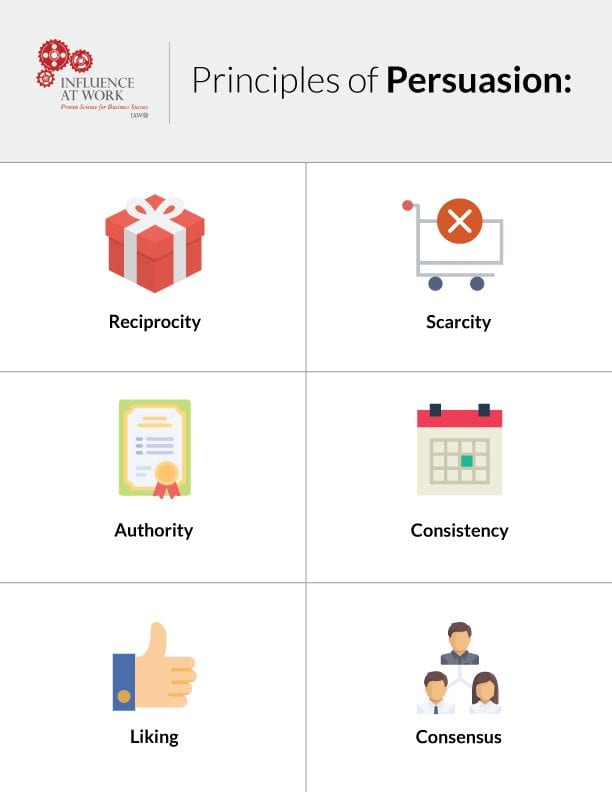Persuasion is the social influence of beliefs, attitudes, intentions, motivations and behaviors; it is a form of manipulation based on commitment, and serves to change thoughts and behaviors; persuasion techniques use words to influence others and make the desired changes.
Among the specialists of persuasion, Robert B. Cialdini, an American psychologist, integrated the different techniques of persuasion into six fundamental principles. To do this, Cialdini has worked as a used car salesman, in charities, marketing companies and others.
- While working.
- He used his knowledge of psychology and put them into practice to demonstrate their effectiveness in secret experiments.
- Below.
- You can see each of the six principles on which your persuasive techniques are based.
Robert B. Cialdini incorporated persuasion techniques into six fundamental principles: commitment, reciprocity, social approval, authority, sympathy, and scarcity.
The influence of the principle of coherence is based on the desire to be and appear as a person with consistent attitudes and behaviors over time; under this principle, people are more willing to accept a requirement if they meet their commitments. -The techniques known under this principle are “enter through the door” and the “low ball”.
The door-to-door technique is to ask the person you want to make something of a small commitment, not too difficult not to be denied, and to be linked to our goal. Once this application was accepted, a greater commitment was requested, which was really desired. If the person rejected this second application, it would seem inconsistent.
The low-ball technique is so called because, once an agreement has been established under certain bases or conditions, the bases on which the agreement was reached by placing the worst ones are removed. But, as they had already accepted, people tend to accept the latter. conditions This is one of the most effective persuasion techniques.
People generally need to do favors, reciprocity refers to the need in social relations to restore balance, that is, when we receive something we feel the need to return something, if we want to extract information from someone, the easiest way is for us to make ourselves some personal trust, a small confession or other information in advance, so the person will feel compelled to tell us something in return.
People tend to treat others in the same way as them, and this inertia sets up one of the most effective persuasion techniques. The application of this principle is simple and is fulfilled, for example, when an unexpected gift or exclusive discount is delivered. this psychological mechanism is all the greater since the gift is perceived as something personal and dedicated. Give something so that the other person feels the need to return something.
People, in general, tend to believe that the behavior adopted by a large number of people is valid, we all like to feel the acceptance of the group and we believe that by acting like the others, we reduce the risk of mistakes.
This is the psychological mechanism by which we tend to accept the opinion of the majority: we are more likely to accept something if others have already accepted it, and also reject it if others have rejected it. Its application is very common: if we find that a product has received very positive feedback, we are more likely to buy it as well. Similarly, if we find that a brand has many followers on social media, we’re more likely to follow it as well.
According to the principle of authority, we are more likely to be influenced when challenged by an authority, this has nothing to do with coertion or the exercise of power, but with the aura of credibility and status that authority implies. believe that those in leadership positions have more knowledge, more experience, or more right to express themselves.
In the principle of authority two elements come into play: hierarchy and symbols, the hierarchy is based on the belief that people who reach higher positions in the hierarchy have more knowledge and experience than others; For their part, symbols bring credibility: the police uniform, the expensive suit of a banker, the shield of a doctor, the titles of master . . . An example is when a celebrity recommends a product or defends an idea, even when what it promotes is not related to its activity (the actor who plays the role of Dr. House advertising medical products).
By building a bond of sympathy and similarity, it is easier to persuade. The principle of sympathy tells us something that at first glance may seem simple: we are more likely to be influenced by the people we love, let alone the people we don’t like. .
Beauty, resemblance, familiarity, praise and exaltation are some of the factors used to provoke sympathy and with which we are able to seduce ourselves. The use of models and celebrities in advertising is based on their sympathy and familiarity. In politics, they often reinforce the idea that candidates are ordinary people concerned about the same problems that affect them.
We tend to believe that there are resources to save for all, but when a resource is scarce we will increase the value we assign to it, scarcity may be limited by time or accessibility, ultimately the perception of scarcity generates demand.
This principle is used through offers for a certain period of time, as discounts or by creating limited editions, the harder it is for us to achieve, the more valuable we will attribute to them; the same goes for prohibition. While an object is prohibited, the effect is an immediate increase in the public interest, such as drugs.
Persuasion techniques are exploited by advertising and advertisements to try to get what they want from us or the commitment they are going to get. Now that we know them, we will know how to identify them and be able to control their influence.

